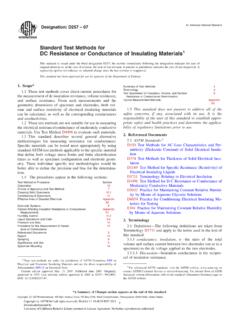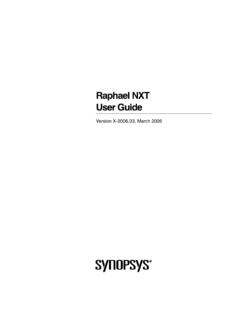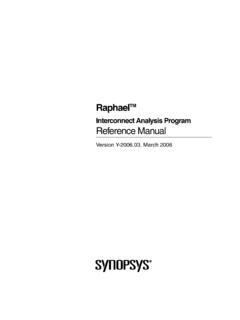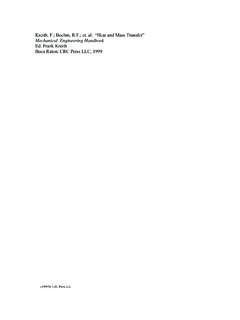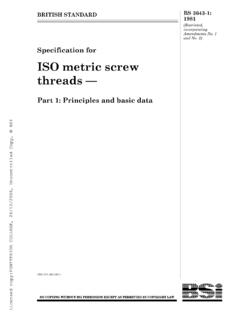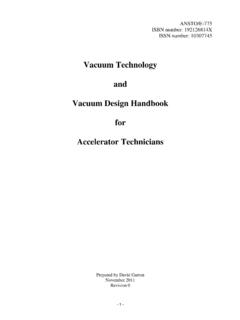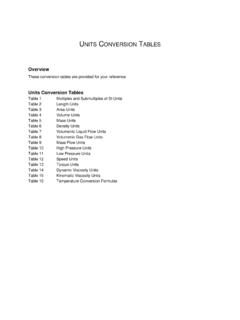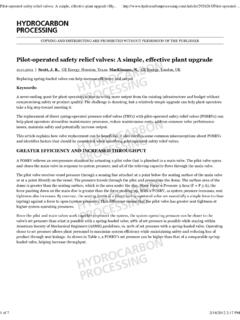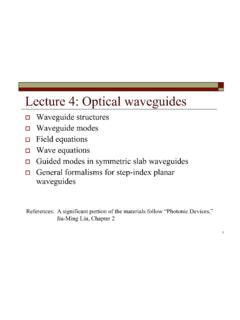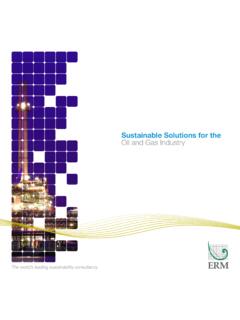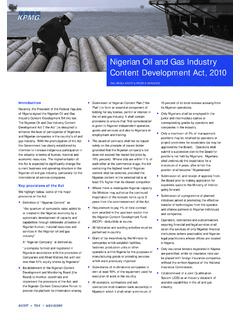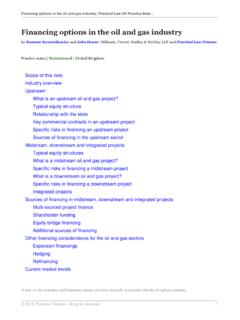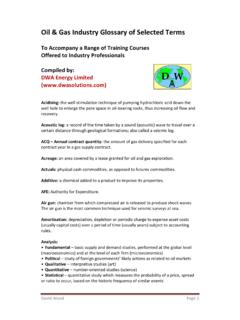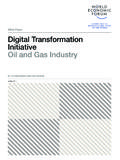Transcription of Guidelines for the CONTROL OF STATIC ELECTRICITY IN …
1 ARCHIVE. Guidelines for the CONTROL OF STATIC . ELECTRICITY IN. industry . ARCHIVE. Published by the Occupational Safety and Health Service Department of Labour Wellington New Zealand First published: 1982. Revised: 1990. PDF created for web site: November 1999. ARCHIVE. CONTENTS. 1. 2. GENERAL HAZARDS AND PROBLEMS ..4. 3. STATIC ELECTRICITY IN THE INDUSTRIAL 5. Major Industrial Sources of 5. General Means of Discussion of Specific CONTROL 6. Materials Handling 4. HAZARD CONTROL IN SPECIAL PROBLEM PROCESSES AND INDUSTRIES.. 11. Liquids in Moving Belts ..11. Gas Electrostatic Paint and Powder 12. Combustible Explosives ..14. 5. ELECTROSTATIC CHARGE APPENDIX 1: MINIMUM IGNITION ENERGIES FOR SOME COMMON. COMBUSTIBLE VAPOURS AND GASES ..15. APPENDIX 2: MINIMUM IGNITION ENERGIES FOR SOME. COMBUSTIBLE DUST ARCHIVE. 1. INTRODUCTION. STATIC ELECTRICITY is generated by the contact and separation of materials, and clearly this generation often cannot be prevented in the industrial setting.
2 We must therefore aim at CONTROL measures rather than expend energy, time and resources trying to prevent the inevitable. To evaluate the possibility of hazards from STATIC ELECTRICITY existing in an industrial locality or in a particular process, it is necessary to understand the causes and effects of the STATIC ELECTRICITY phenomenon. Matter is composed of atoms that consist of negatively charged electrons circulating about a positively charged nucleus. When the surface electrons of a material are disturbed, an imbalance of negative and positive charges arises between the inter-acting surfaces, and results in the phenomenon known as STATIC ELECTRICITY . A deficiency or surplus of a single electron among 100,000 atoms is sufficient to give a detectable STATIC charge on a surface. Surface disturbances leading to the formation of a STATIC charge can be caused in several ways but they all involve some kind of movement.
3 They can result from induction, from the friction between two surfaces, or from the firm contact and subsequent separation of two materials. One of the materials becomes positively charged and the other negatively charged in the manner noted above and an electrical force of attraction will exist between them since, of course, unlike charges attract. On an earthed conducting material, the charge flows away so rapidly after separation that it cannot be detected. However, if the material is a non-conductor or a perfectly insulated conductor, the electric charge cannot leak away. As this charge is unable to flow, it is called STATIC ELECTRICITY . It is ironic that STATIC ELECTRICITY requires movement for generation. 2. GENERAL HAZARDS AND PROBLEMS. The major hazard posed by STATIC ELECTRICITY is the possible ignition of flammable vapours or powders and this problem is discussed in more detail in Section below.
4 Additional hazards are the production of unexpected shocks in humans that might result in injury caused by involuntary reflex action, and the possibility that false readings will be induced in sensitive instruments where STATIC is present, These hazards may be less significant when compared with the ignition problem but they should still be given consideration. STATIC ELECTRICITY may cause industrial handling problems such as unwanted adhesion or repulsion of sheet paper in the printing industry , damage to delicate integrated circuits by the Guidelines FOR THE CONTROL OF STATIC ELECTRICITY IN industry 4. ARCHIVE. presence of high STATIC voltages, and the blocking of powders and dusts being conveyed in pipes. Each of these problems can be alleviated by careful attention to specific CONTROL measures as discussed later (see Sections , , and ). Returning to the problem of the ignition potential of STATIC sparks, the following conditions are necessary to produce a fire or explosion: (a) Combustible material, gas, vapour or dust, must be present in the flammable range of fuel-to-air ratios for ignition to be possible.
5 (b) A STATIC electric charge must have built up on a non- conducting object, or a conducting object that is insulated from earth, and this charge must have sufficient potential to discharge a spark to a neighbouring, usually earthed object;. (c) The spark must have sufficient energy to ignite the surrounding flammable mixture. Precautions taken against ignition must eliminate at least one of the above conditions. 3. STATIC ELECTRICITY IN THE INDUSTRIAL CONTEXT. Major Industrial Sources of STATIC As noted earlier, STATIC ELECTRICITY is always present in the industrial environment. Examples of typical situations likely to produce STATIC ELECTRICITY are: (a) The use of power, or conveyor belts in which non-conductive materials move over or between pulleys and rollers;. (b) Pulverised materials or dusts passing through chutes or being conveyed pneumatically;. (c) The flow of fluids through pipes or conduits, or from orifices into tanks or containers.
6 (d) The flow of gases from orifices;. (e) The use of rubber-tyred vehicles;. (f) The general accumulation of STATIC charge on personnel in the work place, particularly when they wear overalls made of synthetic materials. General Means of CONTROL The principal methods used in industry to prevent the build-up of STATIC electric charges to dangerous levels are: (a) Bonding and earthing of stationary conductive equipment;. (b) Increasing the conductance of floors, footwear, wheels and tyres;. (c) Increasing the conductivity of non-conductors by Guidelines FOR THE CONTROL OF STATIC ELECTRICITY IN industry 5. ARCHIVE. incorporating conductive additives, surface layers and films, and by humidification of the atmosphere;. (d) Increasing the conductivity of the atmosphere by ionizing the air. Section considers these measures in more detail. The first task in STATIC CONTROL procedures is to identify all conducting equipment that may be isolated from earth, insulating materials.
7 As noted before, the build-up of STATIC ELECTRICITY on such objects could have dangerous consequences especially as the existence of insulated conductors may not be obvious. Thus even rotating metal shafts may fall into this category if a non-conductive film of oil separates the shaft from the supporting bearings. The most desirable method of CONTROL the prevention of STATIC generation is rarely attainable. The solution to the problem lies in preventing a charge from building up to a hazardous level. A resistance to earth not exceeding I megohm is usually sufficient to prevent the build-up of dangerous STATIC charges, but a lower resistance is necessary when sensitive explosives and unstable chemicals are handled. Hazardous STATIC conditions cannot always be avoided with certainty in some operations, and thus additional precautions must be taken in areas where ignitable mixtures may be present.
8 Industries at particular risk in this respect are chemical and pharmaceutical plants using flammable fluids and combustible dusts. To summarise, the object of most STATIC CONTROL measures is to provide a means by which separated negative and positive charges may re-combine or flow harmlessly to earth before sparking potentials are reached. Discussion of Specific CONTROL Measures Bonding and earthing metal components is generally the single most effective means of CONTROL . Bonding is the process of connecting together two or more conductive objects by means of a conducting wire or strip to eliminate a difference in potential between these objects, , bonding across flanges of a metallic pipe. Earthing refers to the connecting of one or more objectsto the earth by a conducting strip. Permanent earthing and bonding conductors shall be attached by soldering, welding, or suitable screwed terminations.
9 The conductors also shall possess adequate mechanical strength and be made of corrosion resistant metal. Spring-loaded clips may be used to provide earthing Guidelines FOR THE CONTROL OF STATIC ELECTRICITY IN industry 6. ARCHIVE. connections for moveable containers such as metal drums, but must be capable of maintaining metal contact through any paint or surface rust. Earthing clips must be connectedprior to the use of the equipment or the pumping of flammable liquids, and not during use. The integrity of bonding and earthing connections should be tested periodically, and particularly after equipment has been maintained or painted. Further information on bonding and earthing procedures is available in AS 1020 The CONTROL of Undesirable STATIC ELECTRICITY , an endorsed New Zealand standard. Artificial humidification of the atmosphere is useful in certain instances as a backup to other CONTROL measures.
10 A. permanent relative humidity of at least 65% produces a very thin film of moisture on an exposed surface and this provides a conductive path for the dissipation of accumulated charge. The method is best incorporated as part of the air conditioning system. In relative terms, it represents an expensive CONTROL measure and may not be suitable for some processes. Humidification is ineffective with petroleum products as the necessary conducting film cannot build up. In such cases, the conductivity of oils and related products can be increased by using antistatic additives. The conductivity of the air may be increased by the production of electrically charged ions that then provide a path to earth for STATIC charges on equipment. Ionization of the air can be accomplished by: (a) Electrical STATIC eliminators;. (b) Induction needle bars (comb-type eliminators);. (c) Bars employing radioactive sources, which emit ionizing radiation.
